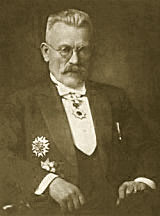Gustaf John Ramstedt facts for kids
Gustaf John Ramstedt (born October 22, 1873 – died November 25, 1950) was a famous Finnish diplomat, expert on Asian cultures, and linguist (someone who studies languages). He was also one of the first people in Finland to learn and support Esperanto, a language created to be easy for everyone to learn. He even led the Esperanto-Association of Finland for a time.
Contents
Early Life and Studies
Ramstedt was born in Ekenäs, a town in Southern Finland. He had several siblings, including Armas Ramstedt, who became a professor of linguistics, Emanuel Ramstedt, a politician, and Rafael Ramstedt, a singer.
Gustaf Ramstedt studied at the University of Helsinki. There, he first focused on Finno-Ugric languages, which are spoken in Finland and nearby regions. Later, he became very interested in Altaic languages, a group of languages spoken across Central and East Asia. His professor, Otto Donner, suggested he travel to Mongolia to study the Mongolian language firsthand.
Adventures in Mongolia
Ramstedt traveled to Mongolia to learn more about Altaic languages. During his trips, he became good friends with Agvan Dorzhiev, an important Buryat Mongol leader. Dorzhiev was a representative of the 13th Dalai Lama and a minister in the Tibetan government. Ramstedt was one of the few foreigners invited to visit Lhasa, the capital of Tibet, but unfortunately, he could not make the trip.
In 1911, a group from Mongolia asked Ramstedt to help them. They wanted him to talk to the Imperial Russian government and ask for their support. Mongolia was trying to become independent from the Chinese Empire. Ramstedt successfully convinced the Russians that the Mongolians were serious. Because of his efforts, Russia supplied 15,000 modern rifles to the Mongolians. These weapons helped them start their fight against Chinese rule.
A year later, in 1912, Ramstedt was in Urga, Mongolia. Mongolian leaders like Da Lama, Chin Van Khanddorj, and Haisan-Gung asked for his help again. They were negotiating with Russian representatives. The Mongolians wanted to unite different Mongolian regions, including Urjanhai and Inner Mongolia, into one large Mongol State. Ramstedt advised them to seek recognition for their new state from other countries too, such as Japan, Britain, Germany, France, and the United States. However, Ramstedt did not know about a secret agreement between Russia and Japan. This agreement said that Inner Mongolia would remain part of China.
Diplomat in Japan
After Finland gained its independence in 1917, Gustaf Ramstedt became Finland's first official representative to Japan. He served as a Chargé d'affaires (a type of diplomat) from 1920 to 1929. While in Tokyo, he often gave lectures at Tokyo Imperial University. He greatly influenced many Japanese scholars, including Kunio Yanagita and Kyōsuke Kindaichi. Ramstedt was known for learning the Japanese language incredibly fast.
Ramstedt's work in Japan also helped solve an important issue for Finland: the Åland Islands dispute. These islands are located between Finland and Sweden. While in Tokyo, Ramstedt wrote a detailed report explaining Finland's view on the situation. This report was used by the Japanese delegation at the League of Nations, an international organization. Japan sided with Finland on the matter, providing crucial support.
Esperanto and Linguistics
Gustaf Ramstedt was one of the first people in Finland to learn Esperanto, learning it as early as 1895. He became the chairman of the Esperanto Association of Finland in 1936 and held that position for several years. During his time in Japan, he both helped and received help from the local Esperanto movement. He even inspired a young poet named Kenji Miyazawa to become interested in Esperanto.
Ramstedt was also a pioneer in studying the number words and their origins in many Asian language families. He researched languages like Turkic, Mongolian, and Tungusic. He also did a lot of work on the history of the Korean language.
Ramstedt passed away in Helsinki.
See also
- Altaic languages
- Dzungarian Gate


